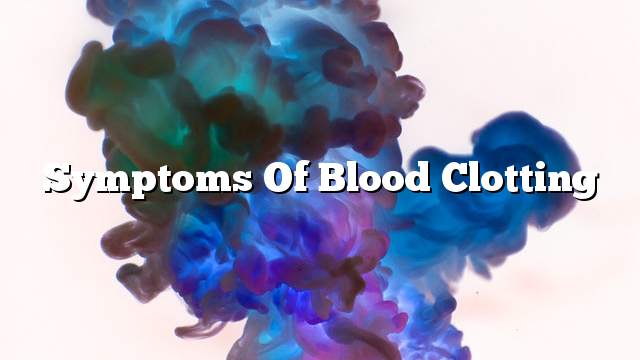Definition of thrombus
Blood clot is defined as a semi-solid or gelous block of blood, formed to prevent the loss of too much blood when exposed to wounds or injuries. Once the wound or injury occurs in the blood vessel, the platelets adhere to the wound and attract more platelets to stop the bleeding. The coagulation factors, which are small particles, produce fibers of the vibrin to stick together and seal the wound from the inside. This leads to healing of the blood vessel and melting. Thrombosis after a few days.
Although thrombosis is usually not harmful if it does not move, it becomes dangerous if it moves from place to place across the veins, as it may stand in place and prevent blood from flowing, which may cause an emergency medical condition.
Symptoms of blood clotting
Blood clotting, also known as stroke, may occur without any symptoms or initial signs, but if symptoms and signs appear, they may be similar to other diseases. About 50% of these clots have no symptoms. These symptoms vary depending on the location of the thrombus as follows:
- Blood clot in the brain: Symptoms include, in addition to sudden and severe headaches, sudden difficulty in vision or speech, as well as other symptoms.
- Blood clot in the heart: This condition is affected by pain and chest pain, as it may cause shortness of breath, headache, and other symptoms. Heart murmurs are not common among people.
- Blood clot in the leg: Symptoms include pain, bloating, discoloration, and feeling warm in the affected area. Symptoms vary depending on the size of the thrombus. Therefore, some people may not have symptoms or may have minor symptoms if the thrombus is small.
- Blood clot in the lung: Symptoms include palpitations, lack of justification for breathing, as well as chest pain, and blood out with cough.
- Blood clot in the abdomen: Symptoms include severe abdominal pain, diarrhea and vomiting.
Factors that require a doctor
There is a great difficulty in diagnosing blood clots through only symptoms. Therefore, it is recommended to contact the doctor in case of suspected thrombosis somewhere in the body. Symptoms that may indicate a thrombus may appear somewhere in the body, which usually comes as a surprise:
- In these cases, you should go to the nearest emergency department. Doctors there are able to determine whether there is actually a thrombus in the body or may be referred for further tests to identify the cause of the symptoms.
Factors that increase the risk of thrombosis
There are several factors that increase the risk of blood clots, including the following:
- Stay in hospital or home without movement for long; so usually after undergoing major surgery.
- Travel on long journeys, especially on trips where the person continues to sit for 4 hours or more.
- Age, especially those over the age of 65.
- Smoking.
- A family history of thrombosis.
- Overweight.
- Pregnancy in women.
- Use of some contraceptive drugs.
Factors that reduce the risk of thrombosis
Tips to consider for the prevention of blood clots include:
- Ask for a doctor’s opinion about the possibility of using blood thinners or compressive stockings to prevent clot formation in the case of long-term hospitalization.
- Talk to your doctor about the possibility of hormonal drugs causing clots.
- Weight loss is excessive.
- Movement at least every hour when traveling by plane or other, especially if the travel time is 4 hours or more.
- Stop driving at least every two hours and do some movement.
- Move the toes and the ankle joint in a circular way while sitting if there is no possibility of standing.
- Exercise and maintain activity.
Treatment of blood clots
Treatment of venous thromboembolism
The patient is usually given intravenous blood clotting drugs to help the thrombus to pass from place. The doctor may also perform a medical procedure for the patient to develop a candidate for the inferior vena cava. This procedure is recommended by people who are most susceptible to thrombosis. To prevent venous thrombosis from moving to the lungs or heart.
Treatment of arterial thrombosis
A doctor may perform a medical procedure known as thrombosis of the catheter, where medication is delivered to break the thrombus or perform a thrombolysis surgery. These treatments are important because arterial thrombosis may prevent blood flow to key organs in the body. These treatments are usually used only in life-threatening situations.
